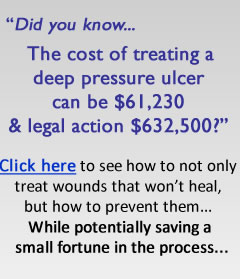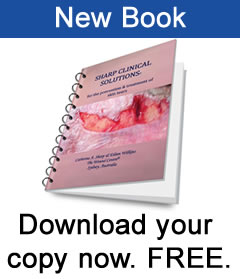Wound infection, dressings and pain, is there a relationship in the chronic wound?
In this really interesting study by Keith Cutting et al, the nature of pain, changes in pain and pain associated with infection are the focal points.
Cutting KF, White RJ, Mahoney P. Wound infection, dressings and pain, is there a relationship in the chronic wound? Int Wound J 2012; doi: 10.1111/j.1742-481X.2012.00947.x http://onlinelibrary.wiley.com
http://www.ncbi.nlm.nih.gov/pubmed Click on either link to get the full paper.
How long should you leave silver wound dressings in place?
How long should you leave silver wound dressings in place and where does the silver go?
Find the answer in this paper by L.J. Wilkinson, R.J. White & J.K. Chipman.
‘Silver and nanoparticles of silver in wound dressings: a review of efficacy and safety.’
Find the article in the Journal of Wound Care 2011 Nov; 20 (11):543-9.
http://www.journalofwoundcare.com/
or on Pub Med
http://www.ncbi.nlm.nih.gov/
More on Incontinence……..
I could find no publications that reported a statistically significant causal link between incontinence and pressure injury (PI) development. An examination of the literature and the risk factors for incontinence, included in many tools reveals the potential difficulty screening poses for healthcare workers. Most PI risk screening tools, as well as the studies that have reported on incontinence as a potential risk factor for PU development, [1] do not differentiate between ‘urinary incontinence’ (UI) and ‘faecal incontinence’ (FI), nor between the different types of UI, stress or functional incontinence.[2]
Many assessment tools have combined urinary incontinence and faecal incontinence, into one risk factor, ‘incontinence.’ It is therefore, difficult to objectively assess ‘incontinence’ as a causal risk factor, or an intervening variable coming after a predictive factor, prior to PI development. However bivariate analysis has shown UI to be associated with a significantly higher rate of PI development.[3] Berlowitz (2001) reported continent residents had a higher rate of PI 90 days after the initial screening than those coded as ‘usually continent’ or ‘incontinent’. This prospective study was carried out on 14,607 nursing home residents who were without a Stage 2 PI, or larger, although these Stages were not defined.
[1] Allman RM, Goode PS, Patrick MM, Burst N. & Bartolucci AA. Pressure ulcer risk factors among hospitalized patients with activity limitation. JAMA 1995; 273(11): 865- 70; Fisher AR, Wells G. & Harrison MB. Factors Associated with Pressure Ulcers in Adults in Acute Care Hospitals. Advances in Skin & Wound Care 2004; 17(2): 80-90; Papanikolaou P. Lyne PA. & Lycett EJ. Pressure ulcer risk screening: application of logistic analysis. J Adv Nurs 2003; 44(2):128-36; Pase MN. Pressure relief devices, risk factors, and development of pressure ulcers in elderly patients with limited mobility. Adv Wound Care 1994; 7: 38–43; Maklebust J, Siggreen MY. Pressure Ulcers. Guidelines for Prevention and Nursing Management. Springhouse PA: Springhouse Corporation, 1996, 24; Versluysen M. Pressure sores in elderly patients. The epidemiology related to hip operations. J Bone Joint Surg Br 1985; 67(1): 10-3; Brandeis GH, Morris JN, Nash DJ et al. The epidemiology and natural history of pressure ulcers in elderly nursing home residents. JAMA 1990; 264:2905–2909.
[2] Klingler HC & Marberger M. Incontinence after radical prostatectomy: surgical treatment options. Urology 2006; 16(2): 60-64
[3] Berlowitz, DR; Brandeis, GH; Morris, J; Ash, AS; Anderson, JJ; Kader, B; Moskowitz, MA. Deriving a Risk-Adjustment Model for Pressure Ulcer Development Using the Minimum Data Set. Journal of the American Geriatrics Society 2001; 49(7): 866-871
This is an excerpt from Sharp CA and McLaws M-L. Estimating the risk of pressure ulcer development: is it truly evidence-based? International Wound Journal December 2006 Volume 3 Issue 4 Pages 344 – 353 and part of my Master of Public Health (res) (UNSW) thesis ‘Pressure Ulcers: risk, physiology and the magnitude of the problem in a Sydney home nursing service.’ (available on Google)
Wound Care Consults for your frail aged.
| Do you work in a residential aged care facility in Sydney? Would you like advice on preventing wounds e.g. skin tears and pressure ulcers or caring for residents with these and other wounds? I can provide wound care consults for you? I can show you how to cut costs while still providing quality care and fulfilling criteria for Skin Care for Accreditation. I can tell you which air mattresses will prevent pressure injuries (PI) and which won’t. Why not give me a call on 0408121331 or email me at info@thewoundcentre.com Kate |
Incontinence causes pressure ulcers…but does it??
If you ‘micro-think’ about this you will see that it makes no sense whatsoever!When a patient is incontinent of urine and / or faeces the wettest, soggiest area is the perineum, vulva, penis and testicles….isn’t it?…not the sacrum and certainly not the heels!
Sure the sacrum might get wet and pooey.. BUT … it is not where the greatest concentration of gloop is found in the incontinentpatient; the sacrum might get damp…but so might the symphysis pubis…both are equidistant from the perineum but I have never seen a Stage 4 PI over the symphsis pubis or abdomen.
Many PI risk assessment tools still include incontinence when assessing patients for risk of PI??
I need to hear a good reason why!! Does anyone have any idea why?


